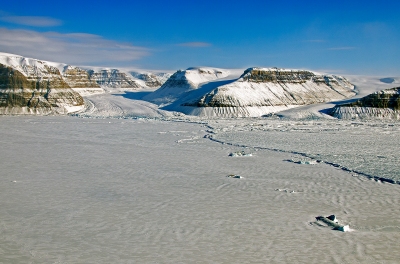When it comes to the issue of climate change, naysayers often contend that we have an incomplete understanding of the Earth’s systems. While humanity is yet to uncover all the secrets of the world, that doesn’t mean we can’t act on what we know. In many cases, as climate scientists delve deeper, they find yet more supporting evidence of the potential turmoil to come.
In the stark landscapes of Greenland, a team of intrepid researchers from the University of California, Irvine, and NASA’s Jet Propulsion Laboratory have unearthed a hidden facet of ice-ocean interaction. Their discovery could potentially flip our understanding of sea level rise on its head.
The Tide Is High
Credit: public
” data-medium-file=”https://platoaistream.com/wp-content/uploads/2023/05/faster-glacier-melting-mechanism-could-cause-huge-sea-level-rises.jpg” data-large-file=”https://platoaistream.com/wp-content/uploads/2023/05/faster-glacier-melting-mechanism-could-cause-huge-sea-level-rises-2.jpg?w=800″ decoding=”async” class=”size-medium wp-image-589668″ src=”https://platoaistream.com/wp-content/uploads/2023/05/faster-glacier-melting-mechanism-could-cause-huge-sea-level-rises.jpg” alt width=”400″ height=”265″ srcset=”https://platoaistream.com/wp-content/uploads/2023/05/faster-glacier-melting-mechanism-could-cause-huge-sea-level-rises-2.jpg 2400w, https://platoaistream.com/wp-content/uploads/2023/05/faster-glacier-melting-mechanism-could-cause-huge-sea-level-rises-2.jpg?resize=250,166 250w, https://platoaistream.com/wp-content/uploads/2023/05/faster-glacier-melting-mechanism-could-cause-huge-sea-level-rises-2.jpg?resize=400,265 400w, https://platoaistream.com/wp-content/uploads/2023/05/faster-glacier-melting-mechanism-could-cause-huge-sea-level-rises-2.jpg?resize=800,530 800w, https://platoaistream.com/wp-content/uploads/2023/05/faster-glacier-melting-mechanism-could-cause-huge-sea-level-rises-2.jpg?resize=1536,1017 1536w, https://platoaistream.com/wp-content/uploads/2023/05/faster-glacier-melting-mechanism-could-cause-huge-sea-level-rises-2.jpg?resize=2048,1356 2048w” sizes=”(max-width: 400px) 100vw, 400px”>
As we grapple with the accelerating impacts of climate change, one of the greatest looming threats is that of rising sea levels. Melting sea ice is no threat, as it doesn’t cause sea levels to rise. Instead, the real problem is land ice, with the vast ice sheets of Greenland and Antarctica acting as colossal water reservoirs. As our planet heats up, these ice sheets melt into the ocean, causing sea levels to rise. This naturally comes with implications for humans. The greatest threat is to coastal communities, where increased flooding or total inundation could make some areas uninhabitable. There’s also the threat that sea level rises could render some agricultural land unusable due to increased salinity, affecting even those who live inland due to food scarcity.
Predicting the extent of sea level rise is a complex puzzle, with many interconnected mechanisms at play. Researchers have to consider factors such as air temperatures, ocean currents, and the physical characteristics of the ice sheets themselves. But as this new research reveals, there might be more to the story.
A large iceberg was spotted calving away from Petermann Glacier in 2012. Glaciers lose mass by melt, sublimation, and by iceberg calving into the sea.
” data-medium-file=”https://platoaistream.com/wp-content/uploads/2023/05/faster-glacier-melting-mechanism-could-cause-huge-sea-level-rises-1.jpg” data-large-file=”https://platoaistream.com/wp-content/uploads/2023/05/faster-glacier-melting-mechanism-could-cause-huge-sea-level-rises-1.jpg” decoding=”async” loading=”lazy” class=”size-medium wp-image-589670″ src=”https://platoaistream.com/wp-content/uploads/2023/05/faster-glacier-melting-mechanism-could-cause-huge-sea-level-rises-1.jpg” alt width=”307″ height=”312″ srcset=”https://platoaistream.com/wp-content/uploads/2023/05/faster-glacier-melting-mechanism-could-cause-huge-sea-level-rises-7.jpg 307w, https://platoaistream.com/wp-content/uploads/2023/05/faster-glacier-melting-mechanism-could-cause-huge-sea-level-rises-7.jpg?resize=246,250 246w” sizes=”(max-width: 307px) 100vw, 307px”>
The scientists focused their study on the Petermann Glacier in northwest Greenland. Using satellite radar data, they found that the glacier’s “grounding line” – the point where the glacier detaches from the bedrock and begins to float in the ocean – moves substantially with the tidal cycles. This movement, significantly larger than expected, allows warm seawater to seep far underneath the glacier, accelerating ice melt. Data collected by researchers suggests that the grounding line is more of a “grounding zone” which migrates from 2 to 6 kilometers as the tide goes in and out.
In essence, the researchers discovered that warm seawater carves channels beneath the ice, particularly at the “grounding zone,” leading to increased melt rates. The team observed a dramatic example of this between 2016 and 2022, when the glacier’s grounding line retreated by 4 kilometers. In the process, a 670-foot-tall cavity formed underneath the glacier, carved out by retreating warm water.
This revelation defies the traditional understanding that these grounding lines remain static during tidal cycles and are immune to melt. The implications of these findings could be significant. The team suggests that if these overlooked ice-ocean dynamics were accounted for in models, estimates of future sea level rise could double. This isn’t just limited to Petermann Glacier – the same could apply to any glacier ending in the ocean. This includes glaciers across most of northern Greenland, as well as Antarctica in its entirety.
dd
” data-medium-file=”https://platoaistream.com/wp-content/uploads/2023/05/faster-glacier-melting-mechanism-could-cause-huge-sea-level-rises-1.png?w=400″ data-large-file=”https://platoaistream.com/wp-content/uploads/2023/05/faster-glacier-melting-mechanism-could-cause-huge-sea-level-rises.png” decoding=”async” loading=”lazy” class=”wp-image-540687 size-large” src=”https://platoaistream.com/wp-content/uploads/2023/05/faster-glacier-melting-mechanism-could-cause-huge-sea-level-rises.png” alt width=”800″ height=”427″ srcset=”https://platoaistream.com/wp-content/uploads/2023/05/faster-glacier-melting-mechanism-could-cause-huge-sea-level-rises-1.png 1784w, https://platoaistream.com/wp-content/uploads/2023/05/faster-glacier-melting-mechanism-could-cause-huge-sea-level-rises-1.png?resize=250,134 250w, https://platoaistream.com/wp-content/uploads/2023/05/faster-glacier-melting-mechanism-could-cause-huge-sea-level-rises-1.png?resize=400,214 400w, https://platoaistream.com/wp-content/uploads/2023/05/faster-glacier-melting-mechanism-could-cause-huge-sea-level-rises-1.png?resize=800,427 800w, https://platoaistream.com/wp-content/uploads/2023/05/faster-glacier-melting-mechanism-could-cause-huge-sea-level-rises-1.png?resize=1536,821 1536w” sizes=”(max-width: 800px) 100vw, 800px”>
This suggests that the already serious problem of sea level rise may be even more urgent than we thought. We’re already aware that the Greenland ice sheet has lost billions of tons of ice over recent decades, largely due to warming subsurface ocean waters. The interactions between this warm water and the ice speed up glacier movement towards the sea, leading to more rapid ice loss.
As our understanding of the intricacies of climate change continues to grow, the Greenland research is a sobering reminder that some variables might remain hidden beneath the ice, so to speak. It’s a classic case of science in action: our models and predictions are only as good as our understanding of the systems involved. As we continue to investigate the depths of climate change, let this be a reminder that there’s always more to learn and that the quest for knowledge is never over, especially when the stakes are so high.
It would be a beautiful moment to find out that some previously-unknown mechanism meant that we would all be safe from the expected dangers of climate change. Sadly, though, most new research seems to confirm we’re in for a bad time, much of it saying the peril is on a more advanced timetable than previously thought.
- SEO Powered Content & PR Distribution. Get Amplified Today.
- PlatoAiStream. Web3 Data Intelligence. Knowledge Amplified. Access Here.
- Minting the Future w Adryenn Ashley. Access Here.
- Buy and Sell Shares in PRE-IPO Companies with PREIPO®. Access Here.
- Source: https://hackaday.com/2023/05/19/faster-glacier-melting-mechanism-could-cause-huge-sea-level-rises/
- :has
- :is
- :where
- $UP
- 1
- 2012
- 2013
- 2016
- 2022
- 214
- 250
- a
- About
- accelerate
- accelerating
- across
- Act
- Action
- actually
- advanced
- affecting
- After
- Agricultural
- AIR
- All
- allows
- already
- also
- always
- an
- and
- Antarctica
- any
- Apply
- ARE
- areas
- AS
- At
- aware
- away
- Bad
- BE
- beautiful
- been
- between
- billions
- Broke
- Broken
- but
- by
- california
- case
- cases
- Cause
- causing
- change
- channels
- characteristics
- classic
- Climate
- Climate change
- come
- comes
- Communities
- complex
- Confirm
- Consider
- continue
- continues
- could
- covered
- credit
- cycles
- dangers
- data
- decades
- deeper
- Depths
- discovered
- discovery
- Doesn’t
- double
- dramatic
- drastically
- due
- during
- dynamics
- entirety
- especially
- essence
- estimates
- Ether (ETH)
- Even
- Event
- evidence
- example
- expected
- factors
- far
- faster
- File
- Find
- findings
- Flip
- Float
- Flowing
- focused
- food
- For
- formed
- found
- from
- front
- future
- get
- Goes
- good
- greatest
- Grow
- Have
- head
- Hidden
- High
- HTTPS
- huge
- Humanity
- Humans
- ICE
- if
- Impacts
- implications
- in
- includes
- increased
- instead
- interactions
- interconnected
- into
- intricacies
- investigate
- involved
- issue
- IT
- ITS
- jpg
- July
- just
- Know
- knowledge
- laboratory
- Land
- large
- largely
- larger
- leading
- LEARN
- Level
- levels
- Limited
- Line
- lines
- live
- looming
- lose
- loss
- lost
- make
- many
- Mass
- max-width
- May..
- mean
- meant
- mechanism
- mechanisms
- Michael
- might
- models
- moment
- more
- most
- move
- movement
- moves
- much
- never
- New
- no
- now
- ocean
- of
- off
- often
- on
- ONE
- only
- or
- our
- out
- over
- particularly
- physical
- planet
- plato
- Plato Data Intelligence
- PlatoData
- Play
- Point
- potential
- potentially
- Predictions
- previously
- Problem
- process
- propulsion
- public
- Pushing
- quest
- radar
- rapid
- Rates
- real
- recent
- remain
- research
- researchers
- result
- Reveals
- Rise
- Rises
- rising
- safe
- same
- saying
- Scarcity
- Science
- scientists
- SEA
- Sea level
- seems
- serious
- several
- sheet
- significant
- significantly
- Size
- So
- sobering
- some
- speak
- speed
- stark
- Story
- Study
- Studying
- substantially
- such
- Suggests
- Supporting
- Systems
- team
- than
- that
- The
- the world
- their
- Them
- themselves
- There.
- These
- they
- this
- those
- though?
- thought
- threat
- threats
- Tide
- time
- timetable
- to
- tons
- Total
- towards
- traditional
- Twice
- uncover
- under
- understanding
- university
- University of California
- urgent
- using
- Valley
- Vast
- warm
- was
- Water
- Waters
- we
- WELL
- were
- What
- when
- which
- while
- WHO
- Wikipedia
- with
- world
- would
- year
- yet
- zephyrnet













